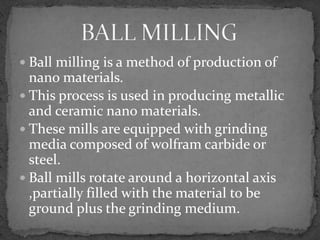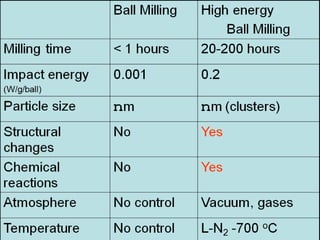Nano Ball Milling
- 1. BALL MILLING METHOD By Aravind N. B
- 2. Nano materials can be defined as those materials which have structured components with size less than 100nm at least in one dimension. Nanotechnology is an advanced technology, which deals with the synthesis of nano-particles, processing of the nano materials and their applications.
- 3. Begin with atoms and molecules(bottom), which react under chemical and physical circumstances to form nanostructure. Eg. Chemical Vapor Deposition(CVD), Atomic Layer Deposition(ALD), Crystal Growth ,etc
- 4. Begin with Bulk Materials(Top) that are subsequently reduced into Nanostructures(Down) by the way of physical, chemical and mechanical processes. Eg: Mechanical-ball milling , extrusion, grinding,etc
- 5. Ball milling is a method of production of nano materials. This process is used in producing metallic and ceramic nano materials. These mills are equipped with grinding media composed of wolfram carbide or steel. Ball mills rotate around a horizontal axis ,partially filled with the material to be ground plus the grinding medium.
- 7. The balls rotate with high energy inside a container and then fall on the solid with gravity force and kinetic and hence crush the solid into nano crystallites.
- 10. Generation of curved or closed-shell carbon nanostructures by ball-milling of graphite Carbon scrolls produced by high energy ball milling of graphite Nanoporous carbon produced by ball milling The nucleation and growth of carbon nanotubes in a mechano-thermal process. Carbon nanotubes formed in graphite after mechanical grinding and thermal annealing.
- 11. Carbon microspheres produced by high energy ball milling of graphite powder Carbon tubes produced during high- energy ball milling process Highly curved carbon nanostructures produced by ball-milling Low energy pure shear milling: A method for the preparation of graphite nano-sheets
- 12. The significant advantage of this method is that it can be readily implemented commercially. Ball milling can be used to make carbon nanotubes and boron nitride nanotubes. It is a preferred method for preparing metal oxide nano crystals like Cerium(CeO2) and Zinc Oxide (ZnO).
- 13. Ball milling of graphite under a hydrogen atmosphere is an effective method of producing nanostructured graphite which is able to store an appreciable amount of hydrogen. Nanostructured graphite has potential for use as a low-cost in energy store, for vehicles and stationary hydrogen-energy applications.














